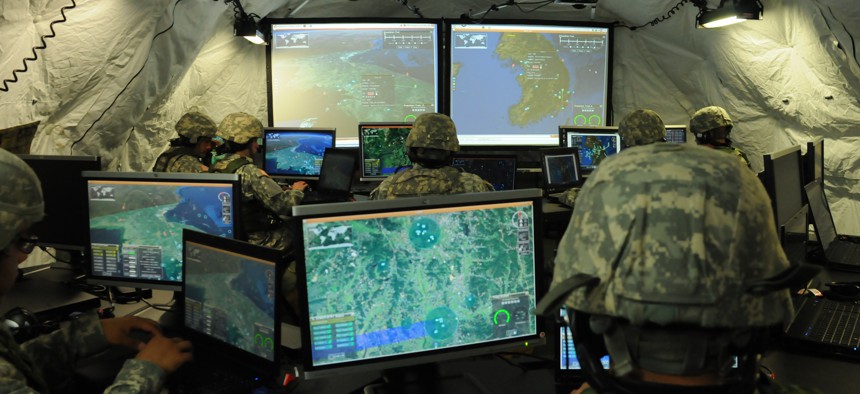The US Army Urgently Needs a Modern Air-Defense Control System
It’s got one under development, dubbed IBCS. It’s delayed, over budget — and vital to American security.
As North Korea continues to test its missiles and demonstrate its intransigence in word and deed, Adm. Harry Harris wants the U.S. Army to step up its role in joint operations. “I’d like to see the Army’s land forces sink a ship, shoot down a missile, and shoot down the aircraft that fired that missile – near simultaneously – in a complex environment where our joint and combined forces are operating in each other’s domains,” the U.S. Pacific Command boss said last fall, and again in May.
There’s an Army program in the works that will help meet Harris’ vision, but it is itself under threat.
To meet PACOM’s demands, joint and coalition teams need a combination of interoperable systems, and the tactics, techniques and procedures to fully use them. Combat experience has shown just how challenging command and control is in the modern battlespace. During the invasion of Iraq in 2003, two coalition fighter jets were shot down (with three crewmembers killed), and a U.S. fighter destroyed a U.S. Army Patriot radar with an anti-radiation missile. Serving as the air component commander’s senior representative to the land commander, I saw first-hand how complex a fight that was, even against an enemy that kept its aircraft on the ground and its air defense relatively limited.
The next adversary is not likely to be so compliant. War in Korea would almost certainly begin on North Korea’s initiative, employing many of its 5,000-plus surface-to-air missiles, 600-plus combat aircraft, surface-to-surface rockets and missiles, and conventional artillery. The battlespace would be compressed and more complicated. The entire Korean Peninsula is half the size of Iraq, and metropolitan Seoul is the size of Chicago with over three times the population. The fight would no doubt center around the South Korean capital and the border just to the north, drawing extraordinary numbers of tactical aircraft, air defenses and artillery fire. The degree of difficulty would be significantly increased by the operational necessity of protecting, and in some cases evacuating, large numbers of civilians.
What does that mean in plain English? Command-and-control systems must allow commanders to see through the fog of war to the maximum extent possible, differentiate between friendly and enemy aircraft and weapons, and rapidly use any sensor (radar, electronic, and other) to identify and enable the best shooter to counter a threat. In so doing, the system will preserve limited ammunition and protect coalition forces from friendly fire. These capabilities have to be dependable in harsh environments – not just a burning, dusty desert or a stifling tropical forest, or an urban jungle, but also in the face of electronic and cyber attacks.
That requires a major evolution in the way sensors and shooters work together. As an F-15 pilot, I used my aircraft’s radar to find my target, then to guide my missiles to it. That’s no longer good enough. The goal of modern C2 systems must be a structure that allows any sensor to cue any system to target with the best available weapon within a matter of seconds. That type of system is what commanders need to maintain a technological and decision-making edge.
We have made progress in off-board cueing and target hand-off, but Harris’ vision of integrated, interoperable systems remains too far off. One promising step is the U.S. Army’s quest for a robust C2 capability under its larger Integrated Air and Missile Defense initiative. Dubbed the Integrated Air and Missile Defense Battle Command System, or IBCS, it is a system currently in testing that is intended to provide warfighters a unified and clear view of the battle. Enhanced aircraft and missile tracking will improve the ability of combatant commanders and air defenders to command and control in complex environments.
A fully capable IBCS is a must-have for the US Army to operate effectively in the Korean theater and elsewhere. Unfortunately, the complexity of such a system and additional Army requirements to make IBCS capabilities more robust have pushed, according to media reports, initial operational capability to 2022.
The Army, to its credit, recognized the importance of continued pursuit of a fully modern IBCS. The current budget requests the addition of more than $500 million for additional development, test and evaluation. Given the urgency of the Korean situation, that investment provided must be used wisely: the Army should seek to do some testing in the Korean theater, and, where possible, deploy partial capabilities at the first opportunity.
Some may be tempted to advocate punishing the IBCS program by cuts or cancellation, a common outcome for difficult development programs. The U.S. cannot afford either outcome. Continued development of interoperable and dependable command-and-control systems on the fastest possible timeline makes a statement to both key regional allies and potential adversaries like Kim Jong-un, while allowing our warfighters to effectively command in the most complex environments.





